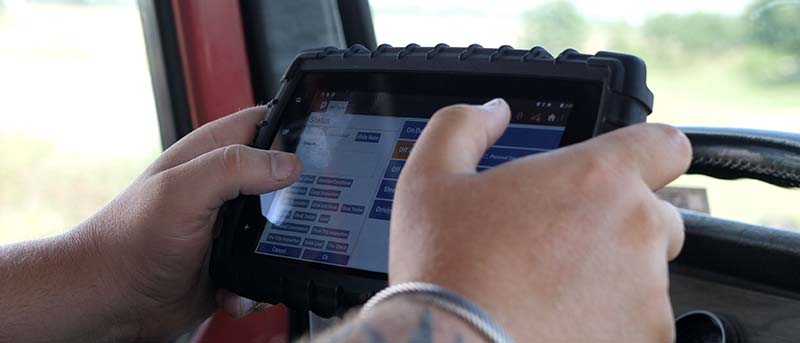Furry Friends Cause Trucking Border Delays At Canadian Border
To prevent reintroduction of rabies carried by dogs into the United States, new CDC regulations require proof of healthy pets at border crossing. Truckers who
We are a team of DOT Compliance and Licensing Professionals helping trucking and transportation companies remain safe, compliant, and profitable.
CNS or Compliance Navigation Specialists is DOT Compliance company that assists trucking and transportation companies remain DOT Compliant. We are part of a network of companies, CNS Companies, specializing in services related to the transportation, manufacturing, construction, service, education and medical industries.

A full-scale DOT Compliance Program managing a long haul carrier’s safety, compliance, licensing and more.
Learn more >>>
A DOT Compliance Program that keeps motor carriers compliant with the 6 Basic DOT Regulations required of all carriers.
Learn more >>>
Our Short-Haul/Construction Program is a full-scale program designed for private carriers that do not haul for-hire.
Learn more >>>
Our most comprehensive DOT Compliance Program, operating as your company’s off-site Safety Director or assisting your current safety personnel.
Learn more >>>
Our Non-CDL Program is a full-scale program managing safety, compliance, licensing and more for moving companies, couriers, landscapers, or any company subject to DOT regulations and does not employ CDL drivers.
Learn more >>>
Our DOT Audit Services cover a number of different types of DOT Audits that new and existing carriers will be subject to.
Our DOT Driver Services help trucking companies and carriers to stay compliant as they grow and hire more drivers.
Our DOT Vehicle Services focus on ensuring your vehicles are compliant with DOT Regulations, which is just as important as your drivers.
Our DOT Services for Special Carriers focus on companies outside of the typical motor carrier, like HAZMAT, Passenger and Bus Carriers.
CNS is part of a group of companies that offer other necessary services for the trucking and transportation industry, such as Commercial Trucking Insurance, CDL Training, Online Training Course, and even Healthcare.
Our DOT Licensing Services will cover you whether you are an existing company or just starting a trucking company. Our DOT Licensing Specialists can help you get up and running and in days with your DOT number, MC Authority, EIN, UCR, IFTA, 2290 HVUT, Fuel Taxes and can even set you up to get your Commercial Driver's License (CDL) with CNS Driver Training Center.
Our DOT Licensing Specialists will help you with every aspect of starting a trucking company. All you need to do is choose a name for your trucking company.
You will need to ensure your DOT Number, MC Authority, Vehicle Registration, etc. is all set up properly when you start your trucking business.
Our Licensing Specialists can help with all aspects of filing and renewing licenses, fuel taxes, etc.
CNS is part of a group of companies that offer other necessary services for the trucking and transportation industry, such as Commercial Trucking Insurance, CDL Training, Online Training Course, and even Healthcare.
To prevent reintroduction of rabies carried by dogs into the United States, new CDC regulations require proof of healthy pets at border crossing. Truckers who
CNS or Compliance Navigation Specialists is DOT Compliance company that assists trucking and transportation companies remain DOT Compliant. We are part of a network of companies, CNS Companies, specializing in services related to the transportation, manufacturing, construction, service, education and medical industries.
CNS Companies is a network of companies specializing in services related to the transportation, manufacturing, construction, service, education and medical industries. Our DOT Compliance division is handled by Compliance Navigation Specialists, CNS Insurance handles Commercial Truck Insurance, CDL training is managed by the CNS Driver Training Center and healthcare is managed by CNS Occupational Medicine.
We are a team of DOT Compliance and Licensing Professionals helping trucking and transportation companies remain safe, compliant, and profitable.
CNS or Compliance Navigation Specialists is DOT Compliance company that assists trucking and transportation companies remain DOT Compliant. We are part of a network of companies, CNS Companies, specializing in services related to the transportation, manufacturing, construction, service, education and medical industries.

A full-scale DOT Compliance Program managing a long haul carrier’s safety, compliance, licensing and more.
Learn more >>>
A DOT Compliance Program that keeps motor carriers compliant with the 6 Basic DOT Regulations required of all carriers.
Learn more >>>
Our Short-Haul/Construction Program is a full-scale program designed for private carriers that do not haul for-hire.
Learn more >>>
Our most comprehensive DOT Compliance Program, operating as your company’s off-site Safety Director or assisting your current safety personnel.
Learn more >>>
Our Non-CDL Program is a full-scale program managing safety, compliance, licensing and more for moving companies, couriers, landscapers, or any company subject to DOT regulations and does not employ CDL drivers.
Learn more >>>
Our DOT Audit Services cover a number of different types of DOT Audits that new and existing carriers will be subject to.
Our DOT Driver Services help trucking companies and carriers to stay compliant as they grow and hire more drivers.
Our DOT Vehicle Services focus on ensuring your vehicles are compliant with DOT Regulations, which is just as important as your drivers.
Our DOT Services for Special Carriers focus on companies outside of the typical motor carrier, like HAZMAT, Passenger and Bus Carriers.
CNS is part of a group of companies that offer other necessary services for the trucking and transportation industry, such as Commercial Trucking Insurance, CDL Training, Online Training Course, and even Healthcare.
Our DOT Licensing Services will cover you whether you are an existing company or just starting a trucking company. Our DOT Licensing Specialists can help you get up and running and in days with your DOT number, MC Authority, EIN, UCR, IFTA, 2290 HVUT, Fuel Taxes and can even set you up to get your Commercial Driver's License (CDL) with CNS Driver Training Center.
Our DOT Licensing Specialists will help you with every aspect of starting a trucking company. All you need to do is choose a name for your trucking company.
You will need to ensure your DOT Number, MC Authority, Vehicle Registration, etc. is all set up properly when you start your trucking business.
Our Licensing Specialists can help with all aspects of filing and renewing licenses, fuel taxes, etc.
CNS is part of a group of companies that offer other necessary services for the trucking and transportation industry, such as Commercial Trucking Insurance, CDL Training, Online Training Course, and even Healthcare.
To prevent reintroduction of rabies carried by dogs into the United States, new CDC regulations require proof of healthy pets at border crossing. Truckers who
CNS or Compliance Navigation Specialists is DOT Compliance company that assists trucking and transportation companies remain DOT Compliant. We are part of a network of companies, CNS Companies, specializing in services related to the transportation, manufacturing, construction, service, education and medical industries.
CNS Companies is a network of companies specializing in services related to the transportation, manufacturing, construction, service, education and medical industries. Our DOT Compliance division is handled by Compliance Navigation Specialists, CNS Insurance handles Commercial Truck Insurance, CDL training is managed by the CNS Driver Training Center and healthcare is managed by CNS Occupational Medicine.

To take Effect Dec. 16, 2017

A federal rule to require truck operators to use Electronic Logging Devices (ELD) to keep records of duty status is slated to be published in the Federal Register, the Federal Motor Carrier Safety Administration has announced. The rule will take effect Dec. 16, 2017, giving carriers and drivers a two-year window to comply with the rule’s requirements.
Upon beginning use of an ELD, drivers will no longer be required to keep and maintain paper logs. They will, however, be required to maintain supporting documentation and submit them to their carrier or, for owner-operators, keep them on file.
The rule requires drivers currently keeping paper logs to use ELDs to keep records of duty service, with a few exceptions.
The devices must be installed and in use by Dec. 16, 2017—exactly two years after its scheduled Dec. 16, 2015, publication date.
The rule also spells out safeguards against driver harassment via the devices, hardware specifications of the devices and supporting documentation drivers must continue to keep after the mandate.
FMCSA says the rule will save the industry $1 billion a year, mostly in time and money saved on paperwork, the agency says. It also says the rule will “save 26 lives and 562 injuries” a year, the agency said in a press release.
Device Specifications
ELDs that meet the minimum standards spelled out in the rule will not be required to track a vehicle or a driver in real-time. They also will not be required to include driver-carrier communication capabilities.
They must, however, be able to automatically record date, time and location information; engine hours; vehicle miles; and ID information of the driver using the device.
The devices must sync with its corresponding vehicle’s engine to record engine on and off time.
The rule also requires compliant devices to be able to transfer data during roadside inspections “on-demand,” via either a wireless Web-based services, email, USB 2.0 or Bluetooth. The rule also stipulates that the ELDs “present a graph grid of a driver’s daily duty status changes either” on the units themselves or in printouts.
CNS has ELD’s available that are compliant with the mandate. Our Compliance Navigation Specialists can help you determine the best route for you and your entire company.
Supporting documents
Drivers, while not required to keep paper logs, still must keep a maximum of eight supporting documents, either electronic or paper, for every 24-hour period that includes on-duty time. They must submit these supporting documents to their carrier within 13 days of receiving them, and carriers must retain the documents — along with records of duty status — for six months.
Supporting documents include:
If a driver submits to a carrier more than eight documents for a 24-hour period, the carrier must keep the first and last document for the day and six others. If fewer than eight are submitted, carriers must retain all of them.
Harassment of drivers
A similar ELD-mandate set for implementation in 2012 was tossed in court over its lack of protection against driver harassment. In accordance with that, FMCSA’s new rule makes it illegal for carriers to use the devices to harass drivers, puts in place fines for doing so and puts in place a system for drivers to report such instances.
The rule defines harassment of drivers via an ELD as any action by a carrier toward a driver that the carrier “knew or should have known” would have interrupted a driver’s off-duty time. “Harassment must involve information available to the motor carrier through an ELD or other technology used in combination with and not separable from an ELD,” the rule states.
Don’t go through this transition alone! Contact us today to help.

Portland, OR ranked 19th for the worst congestion, which costs the average Portland driver $679 and the city $665 million in 2023, according to the

54% of 366,800 drivers are affected by the rule are not using ELDs now. This means nearly 200,000 vehicles will need a new ELD to

No matter if your ELD was revoked or you are changing ELDs voluntarily, there are certain records you must keep for a specific amount of

‘‘Detention time’’ refers to the extra time commercial motor vehicle (CMV) operators wait at shipping and receiving facilities due to delays associated with the loading
Our DOT Compliance Programs ensure it is your top priority and keeps your business running.
Receive the latest transportation and trucking industry information about FMCSA and DOT Audits, Regulations, etc.

Portland, OR ranked 19th for the worst congestion, which costs the average Portland driver $679 and the city $665 million in 2023, according to the

54% of 366,800 drivers are affected by the rule are not using ELDs now. This means nearly 200,000 vehicles will need a new ELD to

No matter if your ELD was revoked or you are changing ELDs voluntarily, there are certain records you must keep for a specific amount of
Join our monthly newsletter and stay up-to-date on trucking industry news and receive important compliance and licensing tips.
Join our monthly newsletter and stay up-to-date on trucking industry news and receive important compliance and licensing tips.